《1. Introduction》
1. Introduction
In rehabilitation operations of ancient riveted metallic bridges, various repairing and reinforcement techniques can be adopted. The riveting technique is often used because it preserves the historical and architectural values of the bridges. However, this process is dangerous and very costly. The welding technique is not suitable for old steels due to their poor weldability properties. The use of high-strength friction grip (HSFG) bolts in metallic connections requires a good friction coefficient between the contactsurfaces and is therefore not a good alternative for old metallic bridges. Fitted bolts are attractive but expensive solutions due to the necessity of preparing the holes. Thus, resin-injected bolted connections appear as a potentially viable solution for repairing and strengthening operations in old riveted construction. Some application examples of resin-injected bolted connections have been used in the repairing and strengthening of old metallic bridges. In Portugal, this technique was used in the rehabilitation of the bridge over the Mondego River in Figueira da Foz [1]. Another well-known example of the application of this solution is the bridge located in Oranienburg, Germany [2].
Injection bolts are no more than standard bolts with a small injection hole in the head of the bolt that allows the resin to be injected, filling the gap between the bolt and the connecting plates. This process improves the slip resistance. An illustration of a resininjected bolted joint (RIBJ) is presented in Fig. 1 [3].
《Fig. 1》

Fig. 1. Illustration of an RIBJ in a double shear connection [3].
Studies related to the mechanical behavior of resin-injected bolted connections have been performed [1,2,4]. These studies have been carried out for quasi-static and creep tests, and for cyclic/dynamic tests related to seismic loading. Connections with resin-injected bolts have a low slip factor, good bearing, and good corrosion resistance. In addition, the injection of epoxy in connection with resin-injected bolts has been shown to be a viable solution [1].
Very few studies evaluate the fatigue behavior of high-cycle regimes of resin-injected bolted connections. The fatigue design codes do not distinguish S-N curves for connections with preloaded high-strength bolts and preloaded injection bolts. As an example, Eurocode 3 (EC3) [5] indicates the same detail category for the referred connections, and suggests detail categories 112 and 90 for double covered symmetrical joints and one-sided connections, respectively. For connections with fitted bolts and non-preloaded injection bolts, the EC3 proposes the same detail category; for example, it proposes detail categories 90 and 80 for double covered joints and one-sided connections, respectively.
Structural adhesives are generally used to improve the strength capacity and to contribute to distributing and transferring the load over the largest area. In bolted connections, the implementation of adhesives is expected to allow the reduction of stress concentration around the holes. There are two failure modes when a structural adhesive is implemented: adhesive failure and cohesive failure. The first occurs when the adhesive and the adherent detach from each other through contact surface, while cohesive failure happens when failure occurs within the adhesive material thickness [6].
Several experimental studies performed in RIBJs have used epoxy-based resins, such as Sikadur®-30 and RenGel®-SW404, since these can provide cold curing, a suitable viscosity for injection, and acceptable mechanical properties [7,8]. More recently, a new epoxy-based resin with the commercial name Sikadur®-52 was introduced onto the market, and stands out for its high strength properties. However, for cyclic fatigue loading conditions, it is important to study the cyclic elastoplastic behavior of structural adhesives, since technical information given by suppliers is mostly related to the static performance.
This paper revisits the experimental results related to the fatigue tests on standard and resin-injected bolted connections that were performed by De Jesus et al. [8]. Single and double shear connections were analyzed using the statistical approaches suggested by the ASTM E739-91 standard [9] and by Castillo and FernándezCanteli [10]. The single and double shear connections under consideration were manufactured with materials from the Trezói Bridge [11] and Fão Bridge [12–14], respectively. Furthermore, experimental fatigue results from Ref. [15] of bolted connections with bonded plates are reviewed. This last study was performed with high-strength low-alloy structural steel plates (minimum yield strength of 345 MPa) and an acrylic structural adhesive for metal bonding. For both case studies, a statistical analysis on the fatigue experimental results is performed using linearized boundaries and the Castillo and Fernández-Canteli model [10], aiming at understanding the influence of adhesives on the fatigue resistance of bolted connections and proposing S-N curves. Afterward, the recommended design curves from several standards (EC3 [5], AASHTO LRFD [16], and BS 5400 [17]) are presented and compared with the proposed ones.
《2. General considerations about S-N curves and statistical models》
2. General considerations about S-N curves and statistical models
《2.1. Overview of fatigue resistance of materials and structural details》
2.1. Overview of fatigue resistance of materials and structural details
Since fatigue problems in structural elements are influenced by several parameters, which are not always independent, design and evaluation procedures are typically empirical in nature. The most common way to represent fatigue damage in materials, mechanical components, or structural details is to use S-N curves. The S-Ncurve relates stress range  to cycles to failure (Nf ), as shown in Fig. 2.
to cycles to failure (Nf ), as shown in Fig. 2.
《Fig. 2》
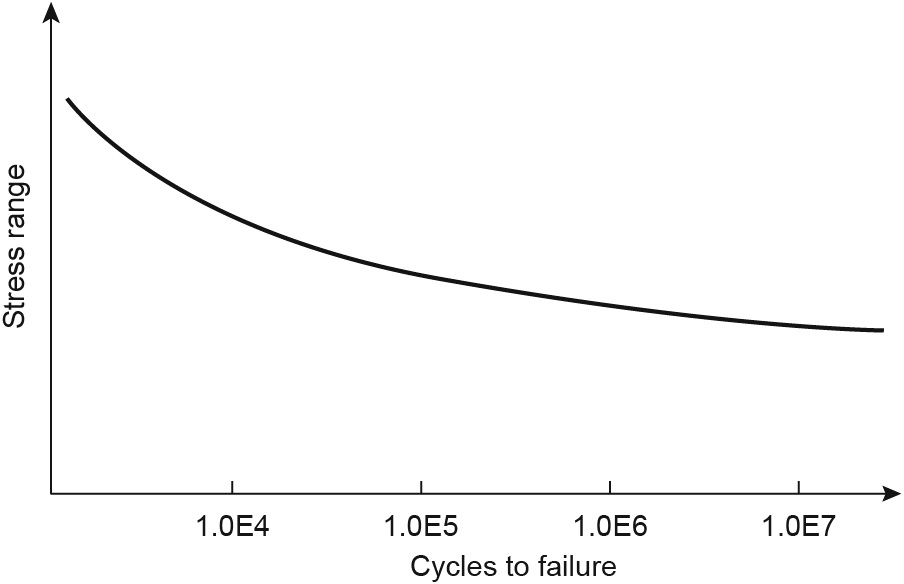
Fig. 2. Illustration of an S-N curve.
A logarithmic scale is normally adopted on both axes in order to establish a linear relation between log and log Nf for most results. This linear relation can then be mathematically expressed by the Basquin relation, as given by Eq. (1):
and log Nf for most results. This linear relation can then be mathematically expressed by the Basquin relation, as given by Eq. (1):

where C and m are constants.
Fatigue assessment in structural details is assured by the design rules available in standards such as EC3 [5], BS 5400 [17], and AASHTO LRFD [16]. However, regarding fatigue design rules for RIBJs, only EC3 explicitly refers to the S-N curve to be used. However, it does not distinguish the fatigue behavior of connections with resin-injected bolts from those with standard bolts, since the same detail category is suggested for both. EC3 presents a set of fatigue strength curves for direct stress ranges, each defined by its detail category (stress range,  at 2 million cycles), as shown in Fig. 3. Table 1 summarizes the detail categories assigned for each type of RIBJ by this European standard. British standard (BS 5400) [17] suggests the use of class D for bolted assemblies, while AASHTO LRFD [16] indicates category B for high-strength bolted joints.
at 2 million cycles), as shown in Fig. 3. Table 1 summarizes the detail categories assigned for each type of RIBJ by this European standard. British standard (BS 5400) [17] suggests the use of class D for bolted assemblies, while AASHTO LRFD [16] indicates category B for high-strength bolted joints.
《Fig. 3》
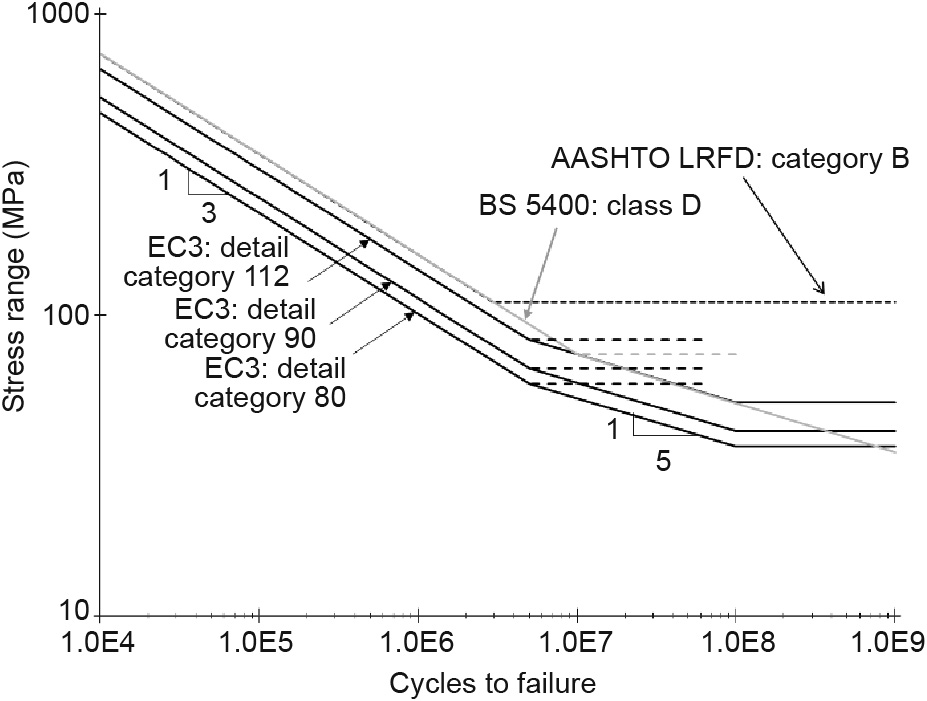
Fig. 3. Fatigue strength curves (related to RIBJs) for direct stress ranges.
《Table 1》
Table 1 Detail categories for different types of RIBJ based on EC3.

《2.2. Statistical approaches to fatigue》
2.2. Statistical approaches to fatigue
By using statistical approaches to fatigue problems, lifetime predictions are in agreement with the principles of the structural integrity criteria of metallic bridges, aeronautic machines, and industry machines, for example. Furthermore, this allows the establishment of suitable safety levels in the fatigue analysis of mechanical components/structural details, concerning the several sources of scatter that may affect fatigue data. The influence of scatter on fatigue results was studied in Ref. [18]. As illustrated in Fig. 4 [18], scatter typically increases as the number of cycles increases and the stress range decreases.
《Fig. 4》

Fig. 4. Influence of scatter in an S-N curve [18] (p corresponds to the probability of failure; σf is the fatigue limit stress).
Zhao et al. [19] developed a probabilistic S-N field directed to long-term regimes. A logarithmical normal distribution was assumed. Schijve [18] focused on establishing a statistical distribution function for the fatigue assessment of structures, but the investigation was restricted to describing specific locations of the S-N field. Another probabilistic approach consists of accounting for the variability of individual parameters/properties of existing deterministic models through adequate probabilistic distributions. This was the case in the work by Correia et al. [20] and Sanches et al. [21] on the probabilistic modeling of the fatigue strength of riveted joints from old bridges. In the literature, a set of probabilistic models can be found that attempt to model the complete probabilistic S-N field [22–24]; more recently, a probabilistic model recommended for medium to high or even very high cycle fatigue was proposed by Castillo and Fernández-Canteli [10]. This work is an important contribution to the analytical probabilistic models for the description of a complete Wöhler field, using both physical and statistical conditions. A more detailed description of this model will be presented later in this paper.
To overcome the scatter of S-N data, the engineering practice considers linear regression analysis on logarithmic data (Eq. (2)), aiming at defining a mean S-N curve with respective standard deviation:

where N* is the dependent variable defined as log Nf ;  is the independent variable defined as log
is the independent variable defined as log  ; and A and B are linear regression parameters that are related to the C and m constants of Eq. (1) as follows:
; and A and B are linear regression parameters that are related to the C and m constants of Eq. (1) as follows:

Thereafter, rectilinear confident bands are established by shifting the mean S-N curve, as expressed by Eq. (4), where α is an integer number and S is the standard deviation of the residuals:

The A and B parameters are estimated through the following equations:

where  are the mean values of the experimental data
are the mean values of the experimental data  respectively; and k is the number of tested specimens.
respectively; and k is the number of tested specimens.
This procedure can be found in material standards such as the ASTM E739-91 [9]. However, this process has a limited application for very high cycle fatigue lives, and it does not account for the variable scatter along the fatigue domain.
As mentioned before, Castillo and Fernández-Canteli [10] proposed a probabilistic model using physical and statistical assumptions that led to a basic probabilistic S-N field, which is defined as follows:

where Nf is the number of cycles to failure;  is the stress range; p is the probability of failure; F is the cumulative probability distribution function of log Nf for a given log
is the stress range; p is the probability of failure; F is the cumulative probability distribution function of log Nf for a given log ; with N0 being a threshold value of lifetime;
; with N0 being a threshold value of lifetime;  being the endurance fatigue limit; and
being the endurance fatigue limit; and  are non-dimensional model parameters (where
are non-dimensional model parameters (where  is the Weibull shape parameter, d is the Weibull scale parameter, and k is the Weibull location parameter defining the position of the zero-percentile curve). Fig. 5 illustrates the Weibull probabilistic S-N field with some representative percentile curves (hyperbolas) delimited by a horizontal asymptote (log Nf = B) representing the fatigue limit and a vertical asymptote
is the Weibull shape parameter, d is the Weibull scale parameter, and k is the Weibull location parameter defining the position of the zero-percentile curve). Fig. 5 illustrates the Weibull probabilistic S-N field with some representative percentile curves (hyperbolas) delimited by a horizontal asymptote (log Nf = B) representing the fatigue limit and a vertical asymptote representing the lifetime threshold.
representing the lifetime threshold.
《Fig. 5》

Fig. 5. Probabilistic S-N field according to the Weibull distribution proposed by Castillo and Fernández-Canteli (p corresponds to the probability of failure).
《3. Experimental fatigue data of bolted connections with adhesives》
3. Experimental fatigue data of bolted connections with adhesives
The use of adhesives in metallic bolted connections under fatigue loading conditions has scarcely been investigated. The main works were carried out by Albrecht et al. [15,25] in 1984/1985 and, more recently, by De Jesus et al. [8] in 2010. In the following sections, these experimental results are summarized/revisited in the form of S-N curves. Two statistical approaches are performed: the first through the implementation of the recommendations of ASTM E739-91 [9], and the second by the application of the probabilistic model proposed by Castillo and Fernández-Canteli [10]. Afterward, the design curves of relevant standards such as EC3 [5], AASHTO LRFD [16], and BS 5400 [17] are compared with the design curves obtained from statistical analysis.
《3.1. Data from De Jesus et al.》
3.1. Data from De Jesus et al.
De Jesus et al. [8] conducted fatigue tests on bolted connections with standard bolts and resin-injected bolts produced with materials from old Portuguese bridges. Two different geometries were used: double shear connections made of puddle iron from the Fão Bridge, and single shear connections made of construction steel extracted from the Trezói Bridge. The Fão Bridge, which was made of puddle iron, was built in 1892. This puddle iron is a heterogeneous material, so there is significant scatter in its material properties. On the other hand, the material from the Trezói Bridge (inaugurated in 1956) is similar to current construction steels.
Studied specimens are presented in Fig. 6. A torque of 80 N m was applied to bolts of all specimens. Bolts, nuts, and washers were adapted to allow resin injection to fill in the radial clearance of 1 mm between the bolts and plates.
《Fig. 6》

Fig. 6. Geometry of the bolted joints (unit: mm; Φ22 is the 22 mm diameter class of bolt). (a) Double shear connection; (b) single shear connection.
In the fatigue tests of the resin-injected bolted connections carried out by De Jesus et al. [8], a commercial epoxy denominated Sikadur®-30 was used [26]. The elasticity modulus of the resin/dhesive is equal to 11.2 GPa for tension loading and equal to 9.6 GPa for compression loading. The monotonic mechanical properties of Sikadur®-30 [26] for a curing time of at least eight days are as follows: 70–80 MPa for compressive strength, 14–18 MPa for shear strength, and 24–27 MPa for tensile strength. It is important to note that all connections with resin-injected bolts were subjected to the same curing time adopted in the mechanical characterization of the resins.
The single and double shear connections were tested on MTS 321.21 and Instron 8801 servo-hydraulic machines, respectively. Tests were carried out under a constant stress ratio, namely a stress R-ratio equal to 0 for double shear connections, and a stress R-ratio equal to 0.1 for single shear connections.
Concerning the resin-injected bolted connections, the experimental campaign involved fatigue tests of seven specimens with Fão Bridge material (double shear connection) using a frequency of 5 Hz or 8 Hz and four specimens with Trezói Bridge material (single shear connection) using a frequency that varied between 4 Hz and 8 Hz. The same net stress range,  = 355 MPa, was used for all fatigue tests with double shear connections, while for single shear connections, the net stress ranges varied from 271.5 MPa to 362.8 MPa.
= 355 MPa, was used for all fatigue tests with double shear connections, while for single shear connections, the net stress ranges varied from 271.5 MPa to 362.8 MPa.
Standard bolted connections were composed of seven double shear specimens and three single shear specimens. In the first case, tests were conducted with net stress ranges from 355.5 MPa to 398.6 MPa, using a frequency within a range of 2.5–10 Hz; for single shear specimens, the net stress ranges varied from 271.4 MPa to 362.2 MPa, and the frequency was 4 Hz or 6 Hz.
Fatigue results from resin-injected bolted and standard bolted connections were plotted on logarithmic scales between the net stress range and the number of cycles to failure, as shown in Fig. 7 and Fig. 8, respectively. A statistical analysis was performed for both situations, using linearized boundaries as well as the Castillo and Fernández-Canteli model [10]. The probabilistic S-N fields were defined together with the percentile curves corresponding to probabilities of failure of 1%, 5%, 50%, 95%, and 99%.
《Fig. 7》

Fig. 7. Fatigue experimental results of resin-injected bolted connections and statistical analysis using linearized boundaries and the Castillo and Fernández-Canteli model [10] (p corresponds to the probability of failure).
《Fig. 8》

Fig. 8. Fatigue experimental results of standard bolted connections and statistical analysis using linearized boundaries and the Castillo and Fernández-Canteli model [10] (p corresponds to the probability of failure).
Through the two statistical methodologies performed on the experimental results, fatigue design curves for resin-injected bolted and standard bolted connections were proposed. In the case of ASTM E739-91 [9], fatigue design curves were defined for a = -2; in the case of the Castillo and Fernández-Canteli model [10], design S-N curves were obtained for the percentile curve corresponding to probabilities of failure of 5%.
The obtained design curves for resin-injected bolted and standard bolted connections through statistical analysis are presented in Fig. 9. It is observed that the design curves obtained from the application of the Castillo and Fernández-Canteli model [10] indicate that the use of resin-injected bolts in connections led to lower fatigue resistance results in several fatigue domains. Linearized boundaries strengthen the idea of worst fatigue strength for injected bolts, although only for a low number of cycles.
《Fig. 9》

Fig. 9. Comparison between fatigue behavior of resin-injected bolted and standard bolted connections through the design curves obtained from statistical analysis.
A possible explanation for this observation is advanced in Ref. [8], where it is related to the effects of preload. Clamping stress has a beneficial effect on bolted connection due to the reduction of stress concentration around the holes. In connections with standard bolts, the contact between the bolt and the hole leads to an increase of clamping stress. On the other hand, filling the clearance in the hole with resin leads to a reduction in the magnitude of compressive stresses and clamping stresses. It is also important to note that the microstructural characteristics of old materials from ancient metallic bridges can justify the reduction of the fatigue strength of resin-injected bolted connections when compared with standard bolted connections. The microstructure of the materials is a ferritic matrix with many inclusions by deformation, limiting the ductility of the material and increasing the scatter of the monotonic and fatigue mechanical properties [27–30]. However, this assumption requires further investigation in the form of additional testing and numerical simulations.
Since the number of tested specimens was reduced and scatter was significant, all results were considered together in order to propose a fatigue design S-N curve. Fig. 10 presents the design curves obtained through the statistical analysis performed on all fatigue data—namely, the lower boundary of 95% of the confidence band defined through implementation of ASTM E739-91 [9] (mean S-N curve: 2S), and the percentile curve corresponding to a probability of failure of 5% through the implementation of the Castillo and Fernández-Canteli model [10].
《Fig. 10》

Fig. 10. Comparison between fatigue design curves obtained from statistical analysis and fatigue design curves recommended in EC3, AASHTO LRFD, and BS 5400.
The S-N curves proposed in EC3 are also included in Fig. 10. This standard does not distinguish between the fatigue behavior of resin-injected bolted and standard bolted connections, since the same detail category is suggested for both. For single shear connections, EC3 recommends detail category 90 when preloaded bolts are included and detail category 80 for connections with nonpreloaded bolts. In the case of double shear connections, this standard indicates detail category 112 when preloaded bolts are included and detail category 90 for connections with nonpreloaded bolts.
An analysis of Fig. 10 shows that the S-N curves from the EC3 standard are generally conservative, since only one data point (which refers to single shear connections built with resininjected bolts) stands below the EC3 detail category 112 curve. The same analysis can be done for the AASHTO LRFD category B and BS 5400 class D design curves.
Additional experimental campaigns are needed, especially for lower values of stress, in order to further verify the capacity of the Castillo and Fernández-Canteli model to properly represent high and very high cycle fatigue.
《3.2. Data from Albrecht et al.》
3.2. Data from Albrecht et al.
In order to prolong fatigue life and increase the fatigue strength of bolted joints, an adhesive material is applied on the plate contact surfaces (shear interfaces). It is expected that the adhesive helps to distribute and transfer the load over a large area, thus reducing stress concentrations. The adhesive chosen to perform the experimental campaign was Versilok 201, an acrylic adhesive. In previous comparative research on several structural adhesives, Versilok 201 has shown higher strength properties at room temperature along with a rapid curing time (15 min): 26.34 MPa for shear strength and 22.82 MPa for tensile strength [25].
Two different types of specimens were used. The differences are in the number of bolts and in the geometry of the plates. One series of specimens was composed of two bolts, as shown in Fig. 11(a) and the other series of specimens was composed of one bolt, as shown in Fig. 11(b).
《Fig. 11》

Fig. 11. Geometry of the tested specimens (unit: mm). (a) Two-bolt specimens; (b) one-bolt specimens.
Steel plates were produced as per the ASTM A588/A588M standard [31], which requires a minimum yield point of 345 MPa. Highstrength bolts with 16 mm diameter were used as well as hardened steel washers and hex nuts. Bolts were tensioned with 84.5 kN, which corresponds to 70% of the specified minimum tensile strength of the bolts. Specimens with the adhesive applied on their contact surfaces are called bonded specimens while specimens with no adhesive are non-bonded specimens.
Specimens were tested under a sinusoidal cyclic load wave with constant amplitude for a stress R-ratio equal to 0. Different frequencies were tested (4 Hz, 6 Hz, 8 Hz, and 10 Hz) along with different net stress ranges (171 MPa, 200 MPa, 219 MPa, and 285 MPa).
3.2.1. Two-bolt specimens
Concerning the fatigue tests of two-bolt specimens, experimental data from bonded and non-bonded specimens were plotted in a logarithmic scale between the net stress range and the number of cycles to failure, as shown in Fig. 12 and Fig. 13, respectively. As in the previous case study, a statistical analysis was performed for both situations using linearized boundaries and the Castillo and Fernández-Canteli model [10].
《Fig. 12》
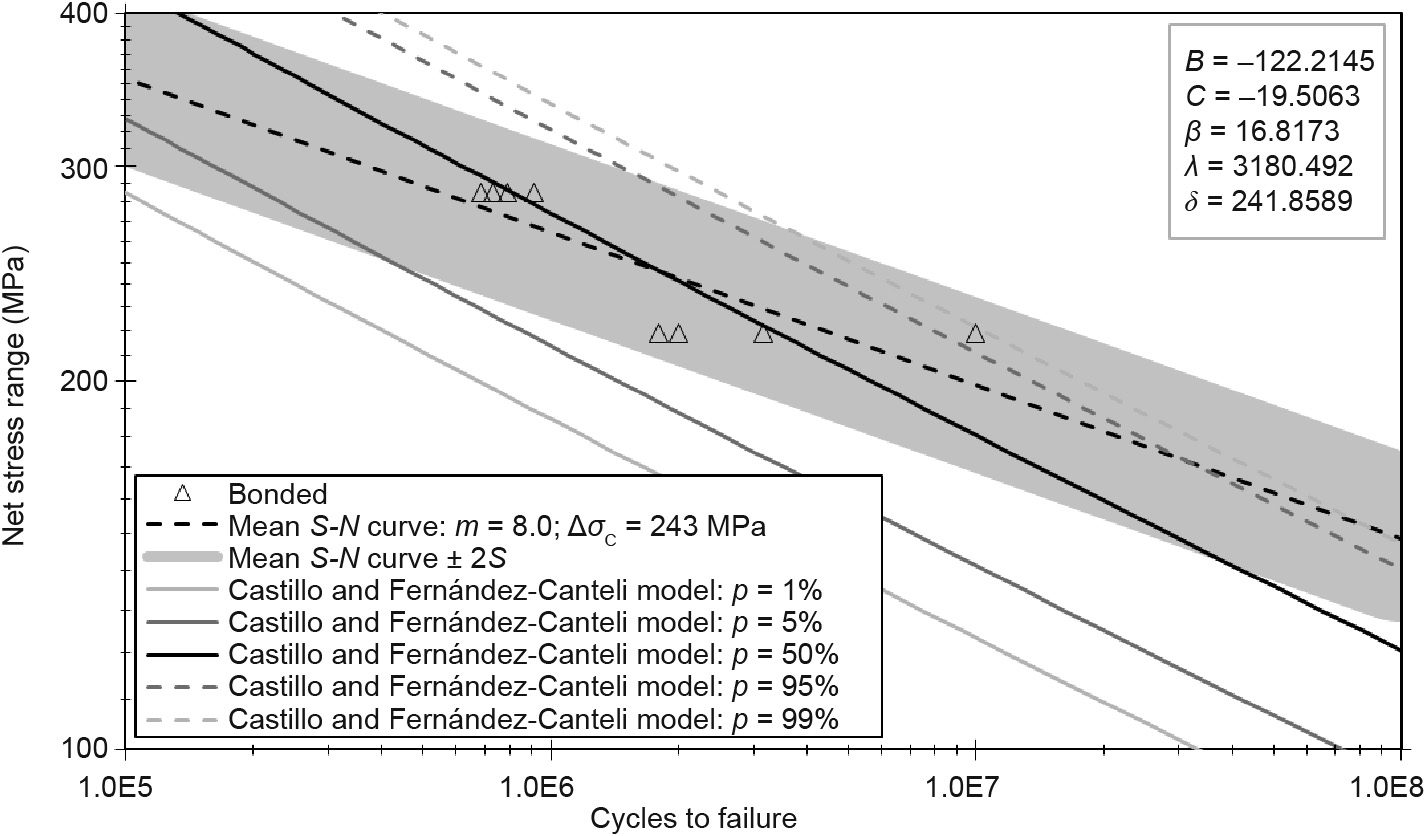
Fig. 12. Fatigue experimental results of two-bolt bonded specimens and statistical analysis using linearized boundaries and the Castillo and Fernández-Canteli model [10] (p corresponds to the probability of failure).
《Fig. 13》
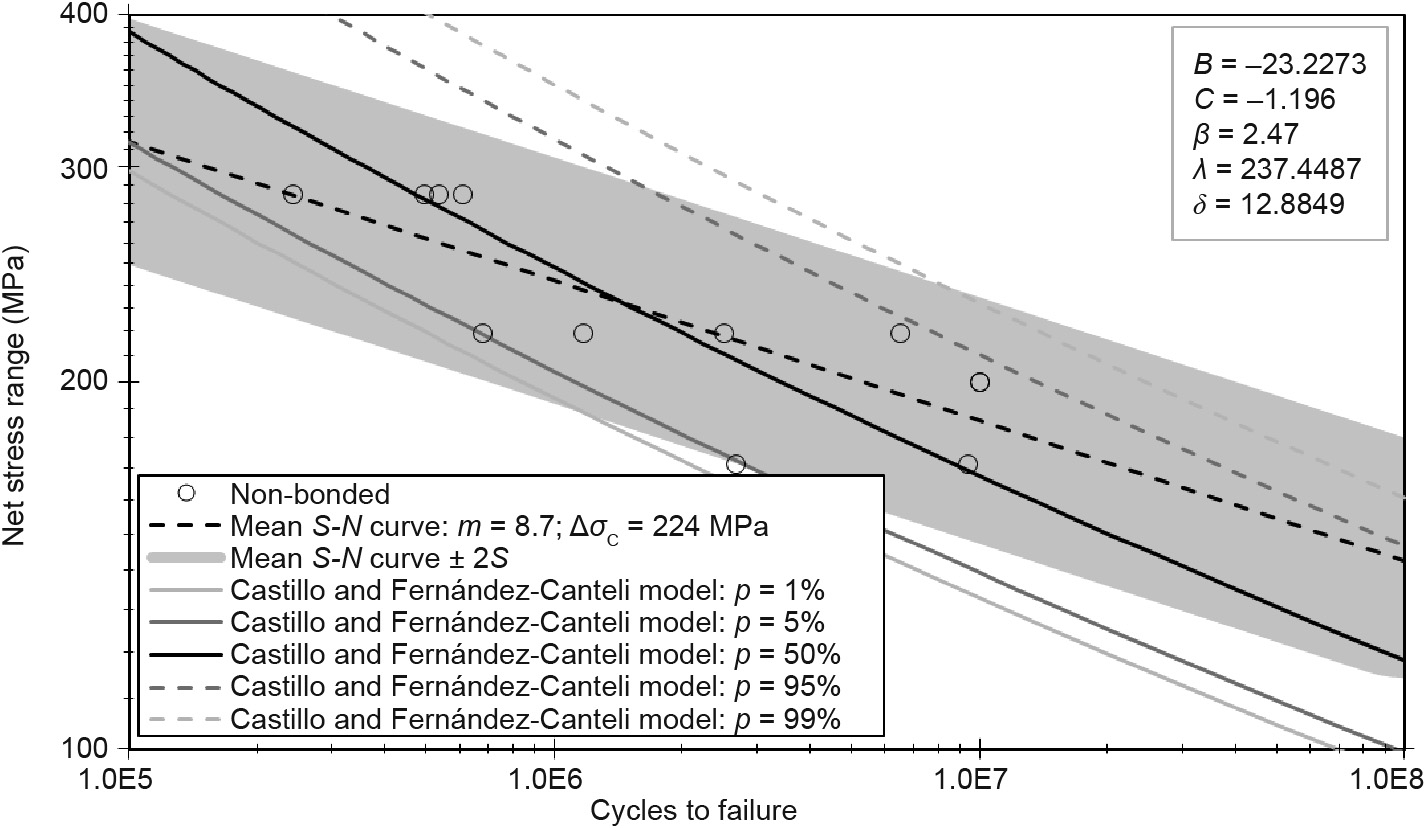
Fig. 13. Fatigue experimental results of two-bolt non-bonded specimens and statistical analysis using linearized boundaries and the Castillo and Fernández-Canteli model [10] (p corresponds to the probability of failure).
Fatigue design curves can be obtained from statistical analysis using α = -2 in the case of ASTM E739-91 [9] methodology and using the percentile curve corresponding to a probability of failure of 5% in the case of the Castillo and Fernández-Canteli model [10] implementation. Consequently, Fig. 14 presents both design curves for two-bolt bonded and non-bonded specimens.
In this case, the design curves obtained from statistical analysis performed with the recommendations of ASTM E739-91 [9] indicate that bonded specimens led to higher fatigue strength results in both low and high cycle fatigue domains. However, the 5% curves of the Castillo and Fernández-Canteli model [10] indicate that the improvement in fatigue strength is not significant when adhesives are implemented, and is even lower for high cycle fatigue domains.
In order to establish a reliable design curve for the obtained results, all fatigue data related to two-bolt specimens were considered together. The lower boundary of 95% of the confident band (mean S-N curve: 2S) was defined, as well as the percentile curve corresponding to a probability of failure of 5% defined through the implementation of the Castillo and Fernández-Canteli model [10], as shown in Fig. 15.
《Fig. 15》
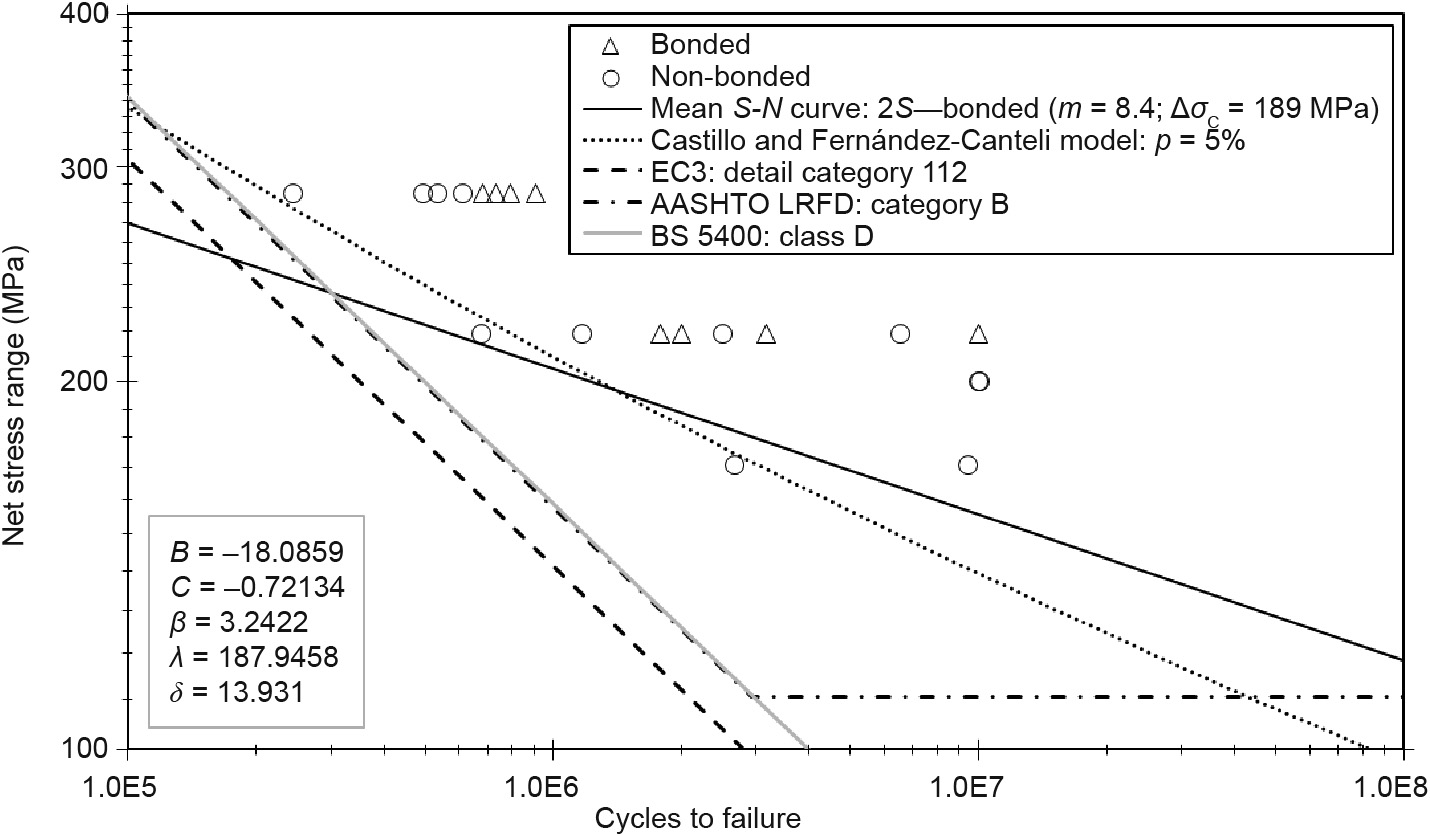
Fig. 15. Comparison between fatigue design curves obtained from statistical analysis and fatigue design curves recommended in EC3, AASHTO LRFD, and BS 5400 (two-bolt specimens).
Fatigue design code curves were added: namely, the EC3 detail category 112 (indicated for double shear joints with preloaded bolts of high strength), the AASHTO LRFD category B, and the BS 5400 class D. All of these represent a conservative lower boundary for fatigue experimental data.
《Fig. 14》

Fig. 14. Comparison between fatigue behavior of two-bolt bonded and non-bonded specimens through the obtained design curves from statistical analysis.
3.2.2. One-bolt specimens
The fatigue results of one-bolt bonded and non-bonded specimens were also plotted on logarithmic scale between the net stress range and the number of cycles to failure, in order to implement the same statistical methods as were used for two-bolt specimens, as shown in Fig. 16 and Fig. 17, respectively.
《Fig. 16》
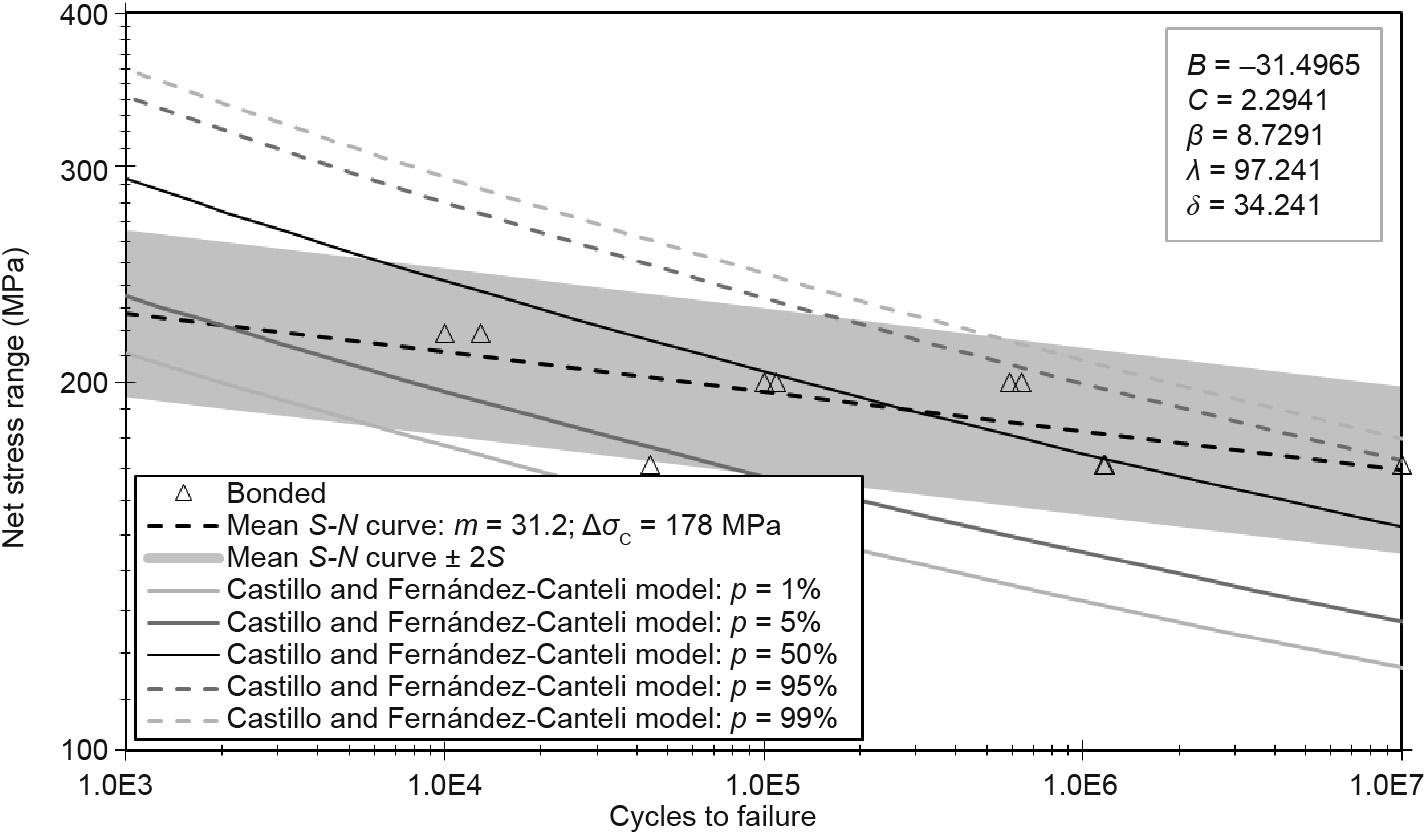
Fig. 16. Fatigue experimental results of one-bolt bonded specimens and statistical analysis using linearized boundaries and the Castillo and Fernández-Canteli model [10] (p corresponds to the probability of failure).
《Fig. 17》
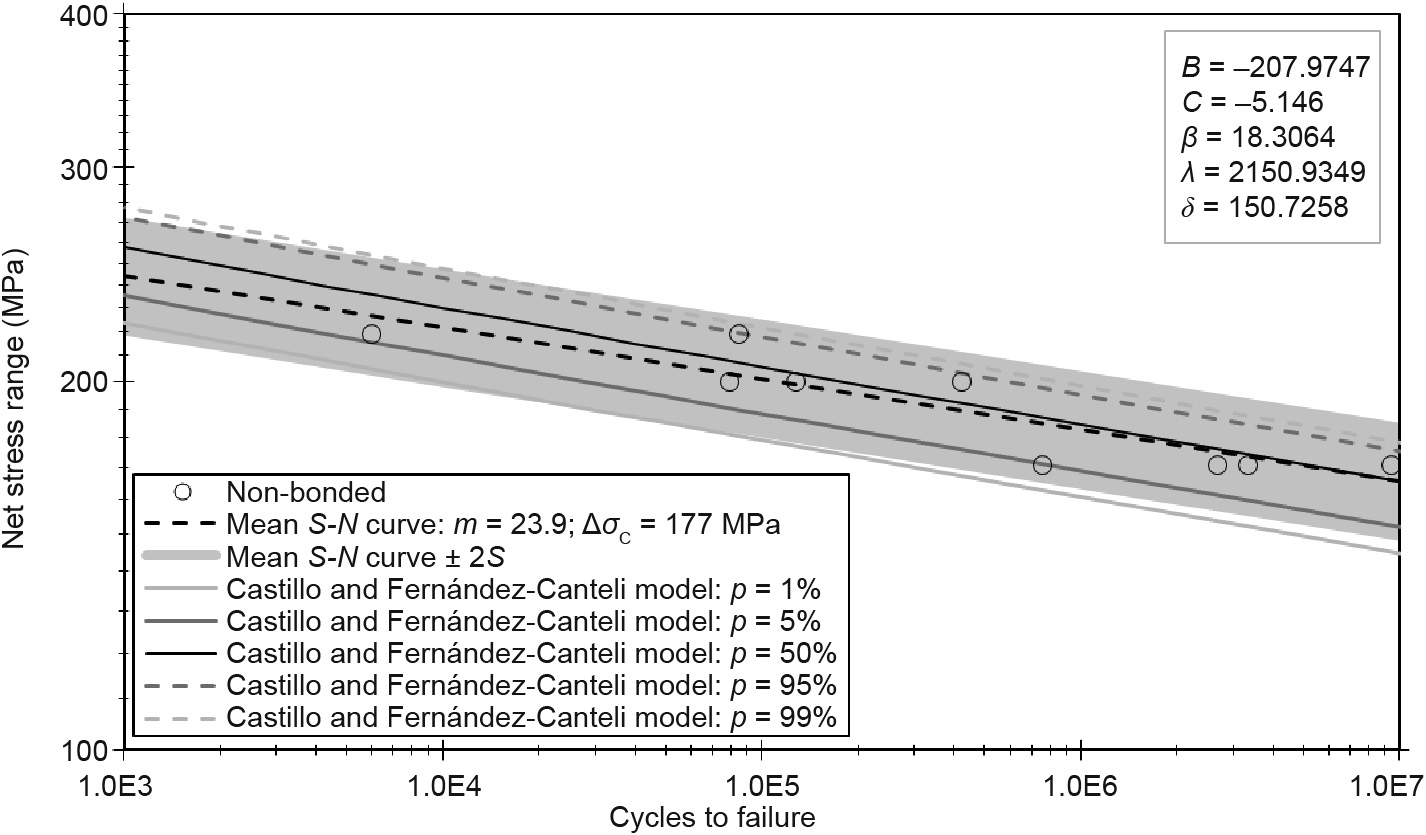
Fig. 17. Fatigue experimental results of one-bolt non-bonded specimens and statistical analysis using linearized boundaries and the Castillo and Fernández-Canteli model [10] (p corresponds to the probability of failure).
As in the previous cases, design curves obtained from statistical analysis were defined for bonded and non-bonded specimens, as shown in Fig. 18. Both statistical methodologies indicate that the use of adhesives leads to lower fatigue strength in both low and high cycle fatigue domains. However, it is important to note that there is insufficient variety in the tested stress ranges, so more experimental campaigns are needed.
《Fig. 18》

Fig. 18. Comparison between fatigue behavior of one-bolt bonded and non-bonded specimens through the obtained design curves from statistical analysis.
The results obtained for one-bolt specimens have a significantly low quality (huge scatter). Meaningless values were obtained due to run-outs or early rupture. Therefore, fatigue design curves obtained from statistical analysis were developed for all fatigue data related to one-bolt specimens, as shown in Fig. 19. The same S-N code curves were implemented. The results showed that when the number of bolts is reduced, the fatigue strength decreases dramatically and S-N code curves are no longer conservative [32].
《Fig. 19》

Fig. 19. Comparison between fatigue design curves obtained from statistical analysis and fatigue design curves recommended in EC3, AASHTO LRFD, and BS 5400 (one-bolt specimens).
《4. Conclusions》
4. Conclusions
This paper reported the statistical analysis that was carried out using the experimental fatigue data collected in the literature on the fatigue resistance of single and double shear connections. These connections were made using old bridge steel plates joined with standard and resin-injected bolts. The bolted connections were made using materials removed from Trezói Bridge and Fão Bridge. Based on experimental data, a fatigue strength reduction for the resin-injected bolted connections was verified. The EC3 fatigue design code indicates the same S-N curves for connections with preloaded high-strength bolts and preloaded injection bolts. Fatigue design curves obtained from the statistical analysis were compared with the standard S-N curves. The available experimental data and the statistical analysis performed both indicate the need to carry out more experimental research supported by numerical modeling on the evaluation of the fatigue behavior of resin-injected bolted connections.
Regarding the experimental results for bolted connections with bonding plates, the main conclusions of this experimental campaign are that adhesive bonding increases the fatigue life when two bolts are present, but if the number of bolts is reduced, a reduction in fatigue life occurs that cannot be recovered by bonding. The bonded joints exhibit a slight increase in fatigue life strength when compared with the non-bonded joints.
Therefore, this paper identifies a research opportunity: In particular, the effects of resin-injected bolts on the fatigue resistance of structural connections need further investigation.
《Acknowledgements》
Acknowledgements
The authors acknowledge the financial support of the Portuguese Foundation for Science and Technology (FCT) through the postdoctoral grant (SFRH/BPD/107825/2015), and the funding of ProLife—Prolonging the Lifetime of Old Steel and Steel-Concrete Bridges (RFSR-CT-2015-00025) by the Research Fund for Coal and Steel (RFCS).
《Compliance with ethics guidelines》
Compliance with ethics guidelines
José António Fonseca de Oliveira Correia, Bruno Alexandre Silva Pedrosa, Patrícia Cordeiro Raposo, Abílio Manuel Pinho De Jesus, Helena Maria dos Santos Gervásio, Grzegorz Stanisław Lesiuk, Carlos Alberto da Silva Rebelo, Rui Artur Bartólo Calçada, and Luís Alberto Proença Simões da Silva declare that they have no conflict of interest or financial conflicts to disclose.














 京公网安备 11010502051620号
京公网安备 11010502051620号




